Despite the unique challenges of aquaculture in northern Australia, the commercial potential of native Blacklip Oysters is gathering momentum
By Annabel Boyer
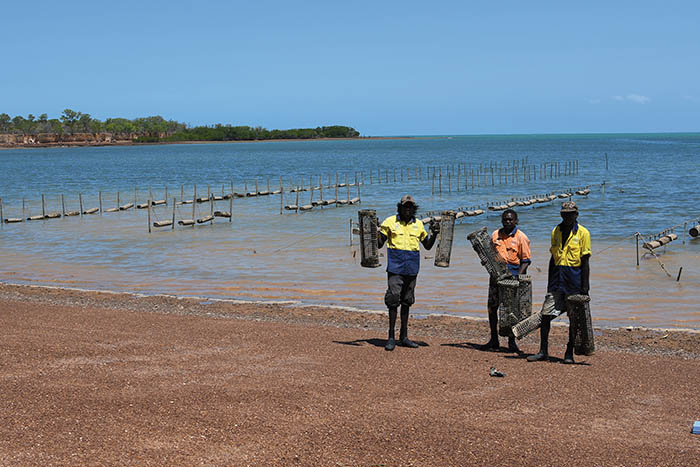
(Left to right) Vernon Garnarradj, Jimmy Galaminda and Maurice Gawayaku at the Yagbani trial farm at South Goulburn Island, NTs.
Photo: Paul Armstrong, Northern Territory Fisheries
When John and Annette Collison moved to Bowen in Far North Queensland in 2014 after more than 32 years growing oysters in New South Wales’s Shoalhaven region, they planned to enjoy a restful retirement in the tropical north, close to their son Nathan Collison.
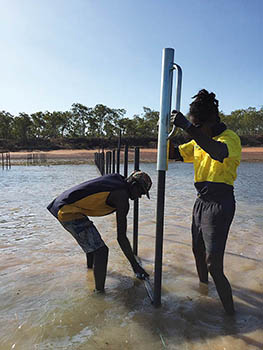
But old habits die hard, and after spotting a few wild oysters on rocks, John Collison decided he might try to grow some, “just to see what happens”.
After four years trialling methods to grow wild-caught oyster spat and rear tropical oysters on a lease outside Bowen, the 68-year-old has demonstrated that the farming of native Blacklip Oysters (Saccostrea echinata) is a real commercial possibility. With half a million juveniles in the water this year, he expects the venture to be profitable in a year or two.
“Blacklip Oysters are an opportunity just waiting to happen,” he says.
They are sweet tasting and relatively fast growing; one stand-out specimen grew to 70 millimetres in just eight months. For comparison, Pacific Oysters generally take about 18 months to reach 75 millimetres, the standard harvesting size.
Tropical rock oysters occur naturally along the coasts of most of northern Australia. The remains of middens along Australia’s coastline are testament to generations of Indigenous Australians feasting on oysters. More recently, they have been wild-harvested off the rocks and bottled for sale.
But it is the prospect of cultivating Blacklip Oysters that has John Collison and a growing number of others excited.
A trial farm on South Goulburn Island has been gradually scaling up its efforts over the last six years. Later this year, the community in the Northern Territory expects to harvest its first significant crop to supply restaurants in Darwin.
“Everyone in Darwin keeps asking me, ‘Where are the oysters?’,” says Warruwi Elder Bunug Galaminda, from the Yagbani Aboriginal Corporation on South Goulburn Island. “The whole community is behind this. It’s been an uphill battle for the past six years, but now everyone wants to get on board.”
Gauging interest
The past year in particular has seen gathering momentum around oyster cultivation in northern Australia from diverse interests that include the FRDC, other government agencies, researchers, existing oyster producers and Indigenous communities.
In October last year, the FRDC funded a workshop in Darwin that brought together a range of players from Western Australia, the Northern Territory, Queensland and NSW, all interested in seeing Blacklip Oysters develop as a commercial crop. The workshop identified research priorities and production challenges, as well as helping to establish networks and project partnerships.
Efforts are underway to address hatchery and husbandry issues, with research aiming to enable commercial spat production of the species.
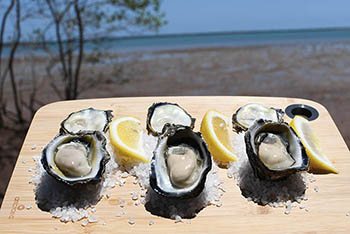
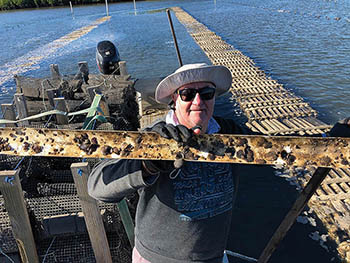
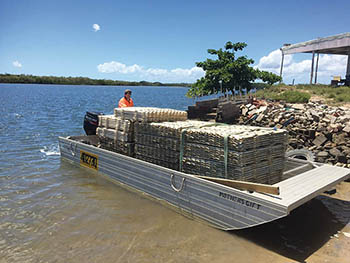
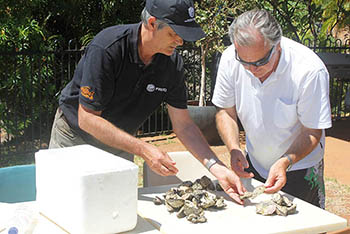
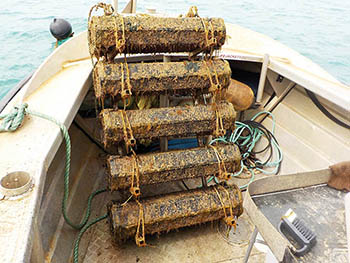
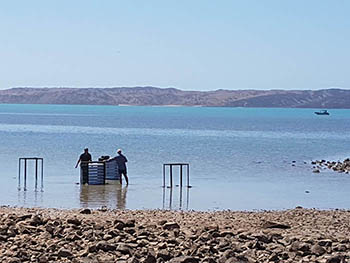
More research is also needed to clarify the species and naming as there is still confusion about whether Blacklip Oysters are a single species, or a sub-species in a larger species complex.
“So far we’ve identified two distinct genetic populations of Saccostrea echinata in the Northern Territory,” says Matt Osborne, who leads the Aquaculture and Regional Development programs of Northern Territory Fisheries.
“But in Western Australia it gets more complicated as to which oysters are there and whether they are different strains or species.”
Investigations into the different species and the genetic make-up of those populations will help set up protocols to protect and preserve local oyster populations. Further investigation of the genetic diversity of northern Australia’s populations will also give information on which strains or species grow where, and which do well in particular conditions.
“Until now, very little research has been done on the Blacklip Oyster,” Matt Osborne says.
“We are working to understand more about the oysters, their natural breeding cycles, the speed at which they grow and the different triggers that induce spawning and settlement. This will help us to assess their commercial viability.”
Pilot projects underway in various parts of WA and the Northern Territory are allowing researchers to monitor variables such as oyster growth and water quality, and do the groundwork to underscore food-safety and quality-assurance processes. These projects are also important learning opportunities for new oyster growers.
Remote economic opportunities
The Yagbani Aboriginal Corporation on South Goulburn Island is one of several Indigenous communities in northern Australia interested in oyster cultivation as a culturally appropriate, sustainable economic opportunity from the land and the sea under their custodianship.
South Goulburn Island has just 300 inhabitants, but they are united in their support of the potential for oyster cultivation to bring employment and revenue.
An initiative of the community-owned Yagbani Aboriginal Corporation, oyster cultivation could become the first non-government economic enterprise on the island.
The trial under way already provides regular work for five people. They regularly inspect and grade the oysters, and keep the baskets free of the algae, barnacles and sea squirts that proliferate in tropical waters.
In WA, Murujuga Aboriginal Corporation has partnered with the FRDC, the Pilbara Development Commission, Maxima Pearling Company and the City of Karratha. In an area famous for mining, oyster cultivation is an opportunity for economic diversification.
General manager of Maxima Pearling Company Steven Gill says the partnership is a win for all.
“We are able to bring our knowledge of aquaculture from our experience growing pearls, and combine that with traditional knowledge from our Indigenous partners,” he says.
“They have knowledge of the local landscape and weather; where the oysters grow; the life cycle, such as when they spawn; and the time of year the oysters are ready to harvest.”
Steven Gill says competition from cheaper pearls in Asia means Maxima is interested in trying out native rock oyster cultivation on some of WA’s 65,000 hectares of pearl leases. It has pilot projects underway in several different parts of the state.
The FRDC is providing 50 per cent of the funding for the Pilbara pilot, which is working on the basic husbandry practices appropriate for the area. These include how many oysters to put in a basket, where in the water column works best, and the kind of gear that is best in the regions they are trialling. Rangers from the Murujuga Rangers program have been monitoring the oysters and checking the lines.
Matt Osborne is also undertaking a mapping project to identify other potential commercial oyster-growing locations in the Northern Territory. The FRDC is funding this project, which will assess whether a potential site is culturally appropriate, close enough to a community to make a venture viable, and suitable from a food-safety perspective. This will include identifying whether cadmium, a heavy metal known to occur in tropical areas, is present at potential sites.
Securing spat
The issue of consistent spat supply in commercial quantities is one of the key concerns for prospective oyster farmers in the Top End.
When John Collison began to farm oysters around Bowen, he found himself catching oyster spat from the wild on plastic oyster slats – something he had not done for decades. With no established hatchery, it was his only option.
But he found he was getting large amounts of spat from the smaller local varieties, rather than from the Blacklip variety that he was interested in cultivating. He says it is almost impossible to tell the species apart until the oysters have grown for about 12 months. Sorting through the oysters for the Blacklips is an expensive and time-consuming process.
The Darwin Aquaculture Centre is also working on the spat issue. It is developing a hatchery manual for Blacklip oysters and recently produced 200,000 spat for the South Goulburn Island trial. Matt Osborne says the centre hopes to be producing commercial quantities of Blacklip Oyster spat within three years, although this service will ultimately need to be provided by industry.
James Cook University in Queensland is considering setting up an experimental hatchery, which might assist John Collison in the long term. In the meantime, he is building a collection of broodstock that he hopes to send to the Albany Shellfish Hatchery in WA once the necessary biosecurity protocols have been established.
The Albany hatchery has supplied quantities of other tropical rock oyster spat to projects in the Pilbara and the Kimberley, from locally harvested wild broodstock.
Northern challenges
The unique challenges and delights of northern Australia include highly variable tides, cyclones, crocodiles and deadly jellyfish, just to name a few. All of these factors complicate the process of oyster farming.
For instance, in Bowen, John Collison says he and his son wear stinger suits to protect themselves against lethal species of jellyfish, such as Irukandji and Box Jellyfish, when they need to get into the water to inspect their oysters. Most of the time, they work from a punt.
On South Goulburn Island, workers use decoys – likened to floating dog toys – to keep crocodiles away from oyster baskets. Despite their large numbers, crocodiles have not caused any problems so far. Matt Osborne says the large tides in the region mean that most husbandry work can be conducted safely on dry land.
The much higher and variable tides in the north do require changes to Australia’s southern oyster farming techniques. But FRDC program manager Wayne Hutchinson says oysters are also farmed in extreme tidal conditions in other places around the world.
“In France, oysters are farmed in places where the tidal zone is 15 kilometres out to sea, which means that workers have to get out really quick to retrieve and check on the baskets,” he says. “This shows that oysters can be cultivated in a whole range of different conditions.”
For John Collison, the major change has been the heat. He has built an air-conditioned cool room, which extends the out-of-water life of his oysters from three days to about six, during grading and handling.
He is also concerned that many novice farmers are likely to enter this space, and that the experience needed to nurture young oysters to maturity without a land-based nursery will prove challenging.
But with the right nurturing of both oysters and growers, the harvest of Blacklip Oysters could soon become a commercial reality. Tropical oysters harvested in winter could neatly fill demand between other oyster harvests in south-east Australia.
John Collison says Bowen already has the infrastructure to air-freight coral trout to Asia, which could be used for oysters in the future.
“With domestic demand and several international markets on our doorsteps – Indonesia, Hong Kong and Singapore – the potential is mind-boggling,” he says.
Photo captions (from top right)
Maurice Gawayaku and Jamie Milpurr installing longline posts at the Yagbani oyster farm.
Photo: Paul Armstrong, Northern Territory Fisheries
Market size Blacklip Oysters from South Goulburn Island.
Photo: Paul Armstrong, Northern Territory Fisheries
John Collison collecting spat on his oyster lease.
Photo: John Collison
Nathan Collison on the Bowen Fresh Oysters lease.
Photo: John Collison
Hutchinson (FRDC) and Jonathan Bilton (Albany Multispecies Mollusc hatchery) sorting adult oysters.
Photo: Pilbarra Development Commission
Oyster baskets from the Pilbara region.
Photo: Pilbarra Development Commission
Steven Gill (Maxima Pearling Company) and Ryan Hall (City of Karratha) installing spat collecting equipment in Flying Foam Passage.
Photo: Pilbarra Development Commission
FRDC Research Codes: 2018-118, 2018-115, 2018-005, 2017-061, 2012-223
More information
Wayne Hutchinson, 0439 636 375
wayne.hutchinson@frdc.com.au





